Organisational Behaviour Report: IKEA Analysis - Unit 12, October 2020
VerifiedAdded on 2023/01/06
|22
|6868
|62
Report
AI Summary
This report provides a comprehensive analysis of organisational behaviour within IKEA. It begins with an introduction to the company and its operational context, followed by an examination of how organisational culture, politics, and power dynamics influence employee behaviour. The report defines organisational culture, explores its impact on organisational behaviour, and discusses different types of organisational culture, including their positive and negative impacts. It then delves into motivational theories, including Maslow's hierarchy of needs and Vroom's expectancy theory, offering recommendations on how IKEA can improve employee motivation and reduce turnover. The concept of team development is explored, with an analysis of the Tuckman model and Belbin team roles, along with challenges in team development and the characteristics of effective teams. Furthermore, the report examines leadership philosophies, specifically path-goal theory and situational leadership theory, along with their merits and demerits and how they can influence behaviour within the company. Finally, the report covers the concept of perceptions, individual differences, and social systems, as applied within IKEA, concluding with a summary of the findings and recommendations.
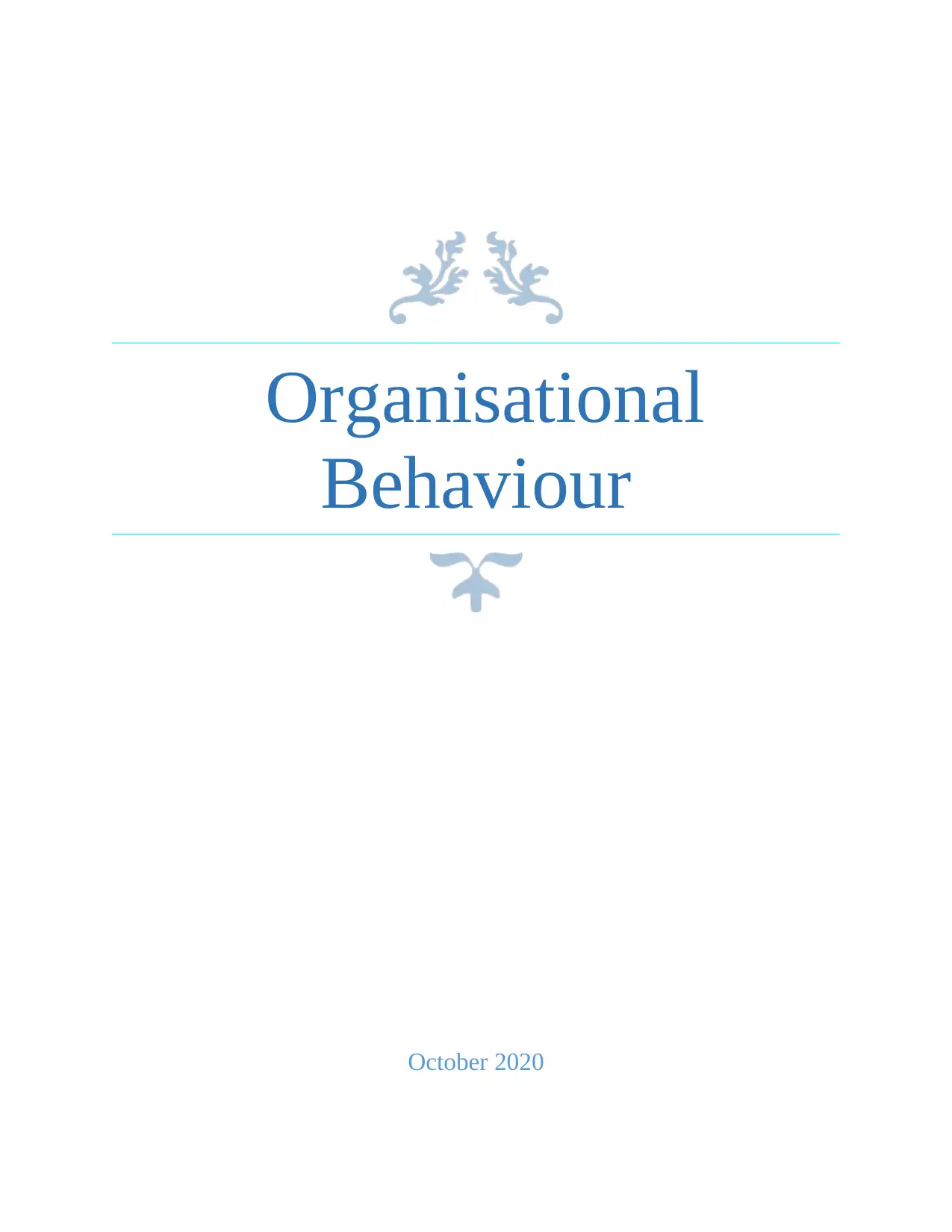
Organisational
Behaviour
October 2020
Behaviour
October 2020
Paraphrase This Document
Need a fresh take? Get an instant paraphrase of this document with our AI Paraphraser
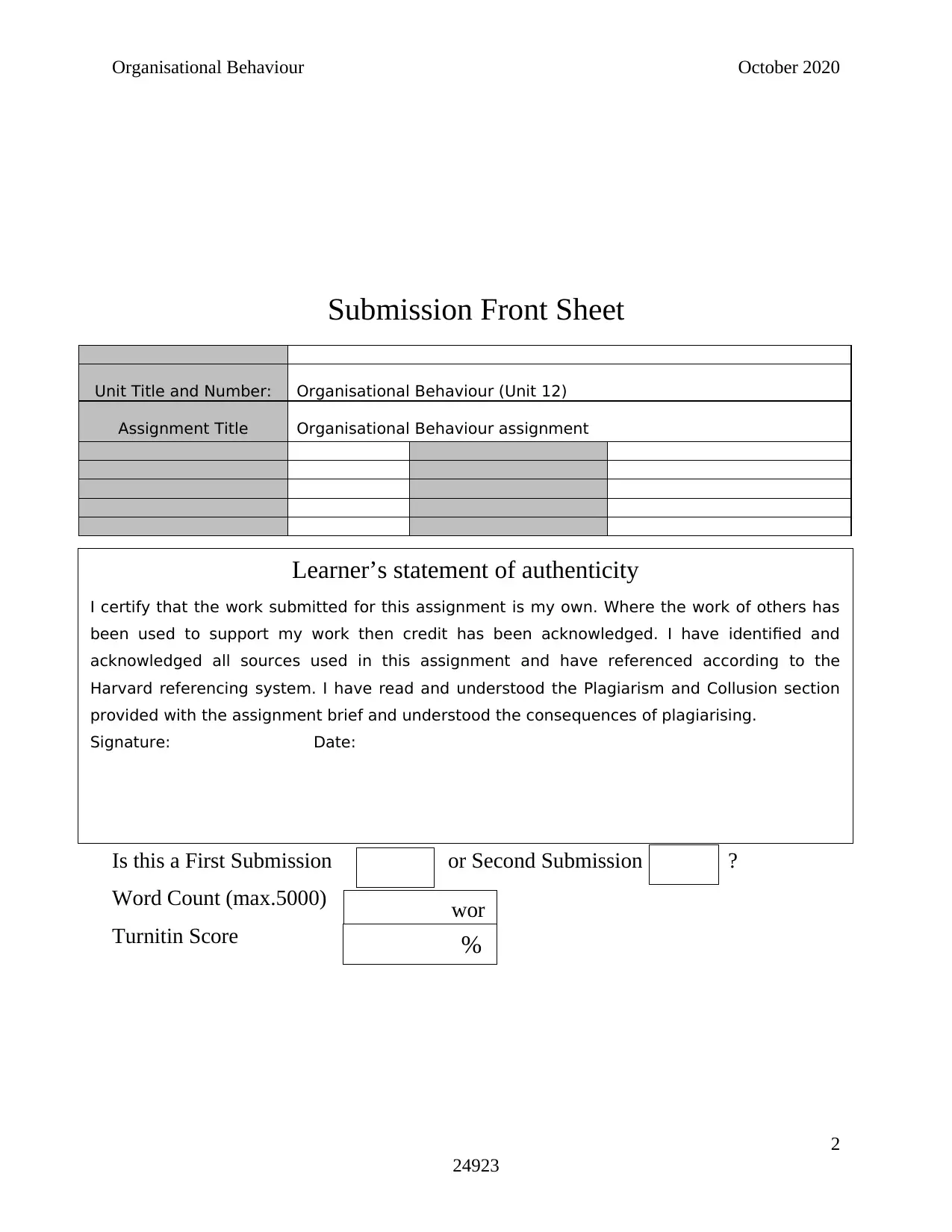
Organisational Behaviour October 2020
Submission Front Sheet
Unit Title and Number: Organisational Behaviour (Unit 12)
Assignment Title Organisational Behaviour assignment
……………………………………………
Is this a First Submission or Second Submission ?
Word Count (max.5000)
Turnitin Score
2
24923
Learner’s statement of authenticity
I certify that the work submitted for this assignment is my own. Where the work of others has
been used to support my work then credit has been acknowledged. I have identified and
acknowledged all sources used in this assignment and have referenced according to the
Harvard referencing system. I have read and understood the Plagiarism and Collusion section
provided with the assignment brief and understood the consequences of plagiarising.
Signature: Date:
wor
ds %
Submission Front Sheet
Unit Title and Number: Organisational Behaviour (Unit 12)
Assignment Title Organisational Behaviour assignment
……………………………………………
Is this a First Submission or Second Submission ?
Word Count (max.5000)
Turnitin Score
2
24923
Learner’s statement of authenticity
I certify that the work submitted for this assignment is my own. Where the work of others has
been used to support my work then credit has been acknowledged. I have identified and
acknowledged all sources used in this assignment and have referenced according to the
Harvard referencing system. I have read and understood the Plagiarism and Collusion section
provided with the assignment brief and understood the consequences of plagiarising.
Signature: Date:
wor
ds %
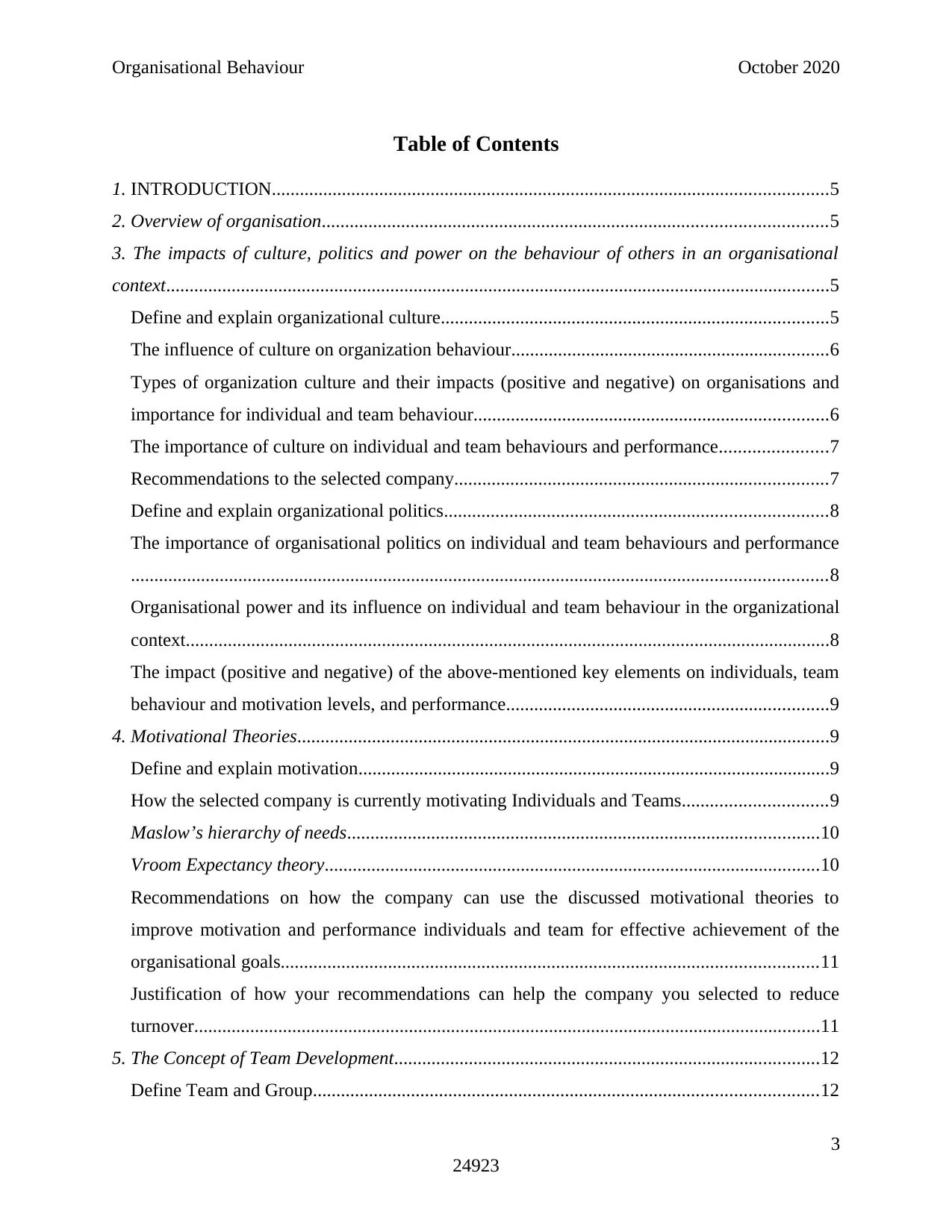
Organisational Behaviour October 2020
Table of Contents
1. INTRODUCTION.......................................................................................................................5
2. Overview of organisation............................................................................................................5
3. The impacts of culture, politics and power on the behaviour of others in an organisational
context..............................................................................................................................................5
Define and explain organizational culture...................................................................................5
The influence of culture on organization behaviour....................................................................6
Types of organization culture and their impacts (positive and negative) on organisations and
importance for individual and team behaviour............................................................................6
The importance of culture on individual and team behaviours and performance.......................7
Recommendations to the selected company................................................................................7
Define and explain organizational politics..................................................................................8
The importance of organisational politics on individual and team behaviours and performance
.....................................................................................................................................................8
Organisational power and its influence on individual and team behaviour in the organizational
context..........................................................................................................................................8
The impact (positive and negative) of the above-mentioned key elements on individuals, team
behaviour and motivation levels, and performance.....................................................................9
4. Motivational Theories..................................................................................................................9
Define and explain motivation.....................................................................................................9
How the selected company is currently motivating Individuals and Teams...............................9
Maslow’s hierarchy of needs.....................................................................................................10
Vroom Expectancy theory..........................................................................................................10
Recommendations on how the company can use the discussed motivational theories to
improve motivation and performance individuals and team for effective achievement of the
organisational goals...................................................................................................................11
Justification of how your recommendations can help the company you selected to reduce
turnover......................................................................................................................................11
5. The Concept of Team Development...........................................................................................12
Define Team and Group............................................................................................................12
3
24923
Table of Contents
1. INTRODUCTION.......................................................................................................................5
2. Overview of organisation............................................................................................................5
3. The impacts of culture, politics and power on the behaviour of others in an organisational
context..............................................................................................................................................5
Define and explain organizational culture...................................................................................5
The influence of culture on organization behaviour....................................................................6
Types of organization culture and their impacts (positive and negative) on organisations and
importance for individual and team behaviour............................................................................6
The importance of culture on individual and team behaviours and performance.......................7
Recommendations to the selected company................................................................................7
Define and explain organizational politics..................................................................................8
The importance of organisational politics on individual and team behaviours and performance
.....................................................................................................................................................8
Organisational power and its influence on individual and team behaviour in the organizational
context..........................................................................................................................................8
The impact (positive and negative) of the above-mentioned key elements on individuals, team
behaviour and motivation levels, and performance.....................................................................9
4. Motivational Theories..................................................................................................................9
Define and explain motivation.....................................................................................................9
How the selected company is currently motivating Individuals and Teams...............................9
Maslow’s hierarchy of needs.....................................................................................................10
Vroom Expectancy theory..........................................................................................................10
Recommendations on how the company can use the discussed motivational theories to
improve motivation and performance individuals and team for effective achievement of the
organisational goals...................................................................................................................11
Justification of how your recommendations can help the company you selected to reduce
turnover......................................................................................................................................11
5. The Concept of Team Development...........................................................................................12
Define Team and Group............................................................................................................12
3
24923
⊘ This is a preview!⊘
Do you want full access?
Subscribe today to unlock all pages.

Trusted by 1+ million students worldwide
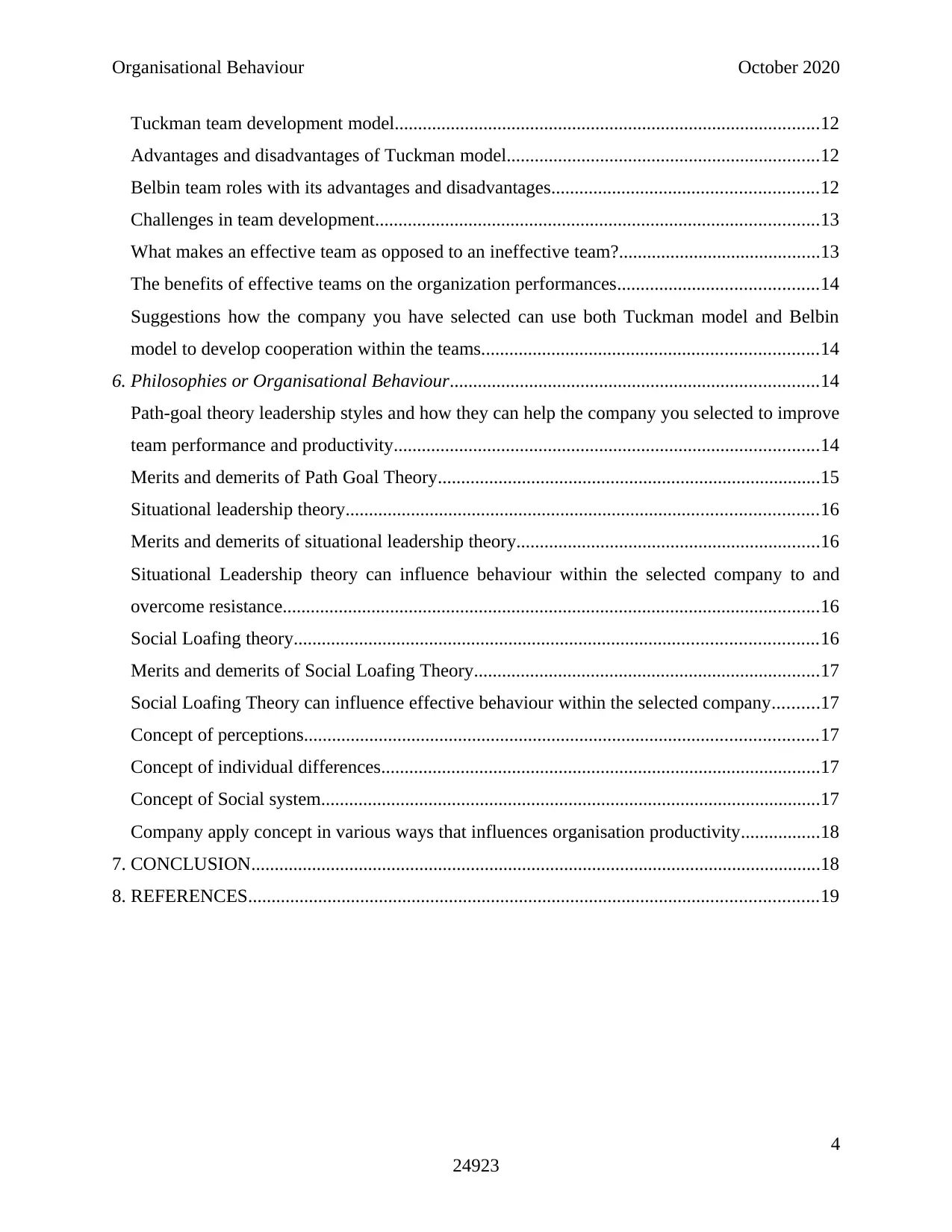
Organisational Behaviour October 2020
Tuckman team development model...........................................................................................12
Advantages and disadvantages of Tuckman model...................................................................12
Belbin team roles with its advantages and disadvantages.........................................................12
Challenges in team development...............................................................................................13
What makes an effective team as opposed to an ineffective team?...........................................13
The benefits of effective teams on the organization performances...........................................14
Suggestions how the company you have selected can use both Tuckman model and Belbin
model to develop cooperation within the teams........................................................................14
6. Philosophies or Organisational Behaviour...............................................................................14
Path-goal theory leadership styles and how they can help the company you selected to improve
team performance and productivity...........................................................................................14
Merits and demerits of Path Goal Theory..................................................................................15
Situational leadership theory.....................................................................................................16
Merits and demerits of situational leadership theory.................................................................16
Situational Leadership theory can influence behaviour within the selected company to and
overcome resistance...................................................................................................................16
Social Loafing theory................................................................................................................16
Merits and demerits of Social Loafing Theory..........................................................................17
Social Loafing Theory can influence effective behaviour within the selected company..........17
Concept of perceptions..............................................................................................................17
Concept of individual differences..............................................................................................17
Concept of Social system...........................................................................................................17
Company apply concept in various ways that influences organisation productivity.................18
7. CONCLUSION..........................................................................................................................18
8. REFERENCES..........................................................................................................................19
4
24923
Tuckman team development model...........................................................................................12
Advantages and disadvantages of Tuckman model...................................................................12
Belbin team roles with its advantages and disadvantages.........................................................12
Challenges in team development...............................................................................................13
What makes an effective team as opposed to an ineffective team?...........................................13
The benefits of effective teams on the organization performances...........................................14
Suggestions how the company you have selected can use both Tuckman model and Belbin
model to develop cooperation within the teams........................................................................14
6. Philosophies or Organisational Behaviour...............................................................................14
Path-goal theory leadership styles and how they can help the company you selected to improve
team performance and productivity...........................................................................................14
Merits and demerits of Path Goal Theory..................................................................................15
Situational leadership theory.....................................................................................................16
Merits and demerits of situational leadership theory.................................................................16
Situational Leadership theory can influence behaviour within the selected company to and
overcome resistance...................................................................................................................16
Social Loafing theory................................................................................................................16
Merits and demerits of Social Loafing Theory..........................................................................17
Social Loafing Theory can influence effective behaviour within the selected company..........17
Concept of perceptions..............................................................................................................17
Concept of individual differences..............................................................................................17
Concept of Social system...........................................................................................................17
Company apply concept in various ways that influences organisation productivity.................18
7. CONCLUSION..........................................................................................................................18
8. REFERENCES..........................................................................................................................19
4
24923
Paraphrase This Document
Need a fresh take? Get an instant paraphrase of this document with our AI Paraphraser
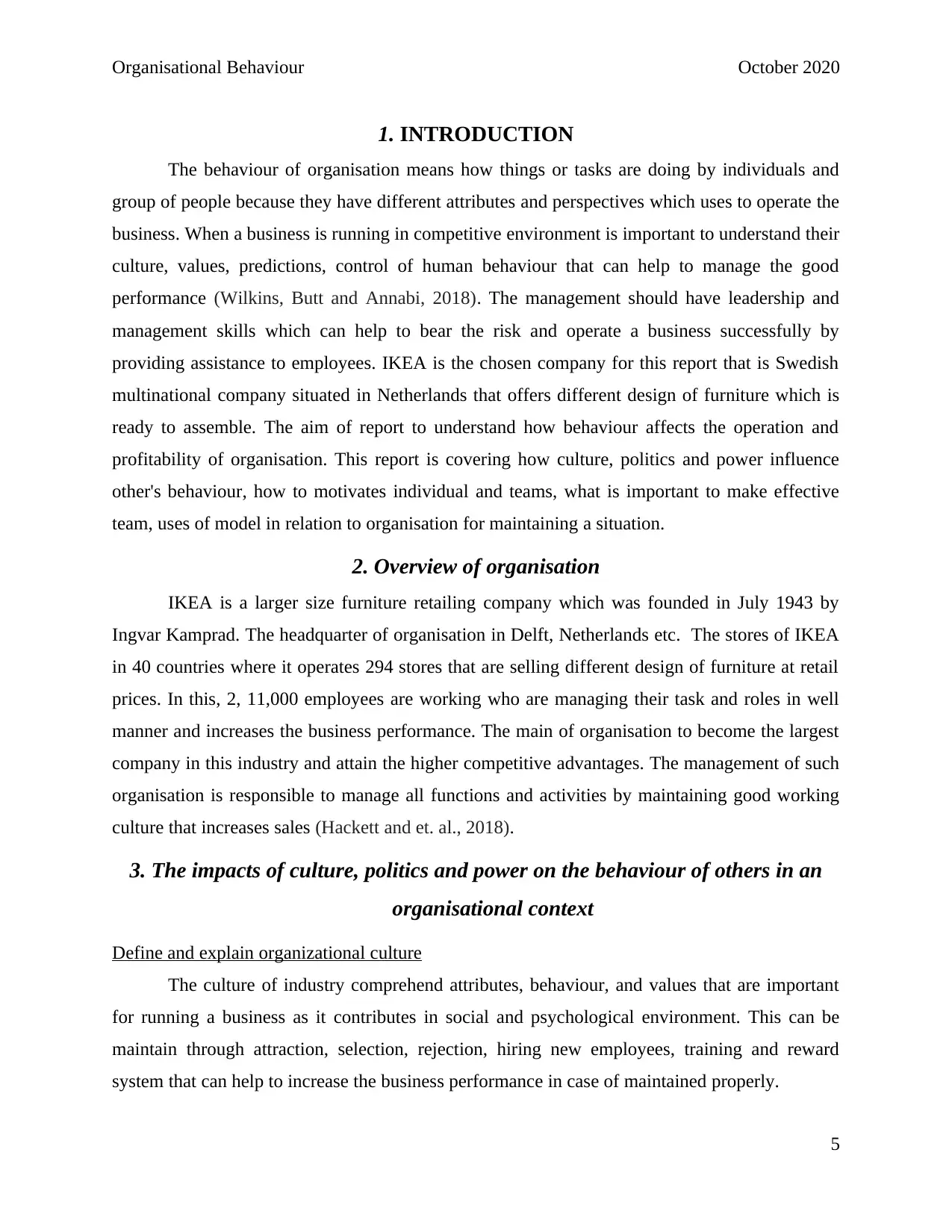
Organisational Behaviour October 2020
1. INTRODUCTION
The behaviour of organisation means how things or tasks are doing by individuals and
group of people because they have different attributes and perspectives which uses to operate the
business. When a business is running in competitive environment is important to understand their
culture, values, predictions, control of human behaviour that can help to manage the good
performance (Wilkins, Butt and Annabi, 2018). The management should have leadership and
management skills which can help to bear the risk and operate a business successfully by
providing assistance to employees. IKEA is the chosen company for this report that is Swedish
multinational company situated in Netherlands that offers different design of furniture which is
ready to assemble. The aim of report to understand how behaviour affects the operation and
profitability of organisation. This report is covering how culture, politics and power influence
other's behaviour, how to motivates individual and teams, what is important to make effective
team, uses of model in relation to organisation for maintaining a situation.
2. Overview of organisation
IKEA is a larger size furniture retailing company which was founded in July 1943 by
Ingvar Kamprad. The headquarter of organisation in Delft, Netherlands etc. The stores of IKEA
in 40 countries where it operates 294 stores that are selling different design of furniture at retail
prices. In this, 2, 11,000 employees are working who are managing their task and roles in well
manner and increases the business performance. The main of organisation to become the largest
company in this industry and attain the higher competitive advantages. The management of such
organisation is responsible to manage all functions and activities by maintaining good working
culture that increases sales (Hackett and et. al., 2018).
3. The impacts of culture, politics and power on the behaviour of others in an
organisational context
Define and explain organizational culture
The culture of industry comprehend attributes, behaviour, and values that are important
for running a business as it contributes in social and psychological environment. This can be
maintain through attraction, selection, rejection, hiring new employees, training and reward
system that can help to increase the business performance in case of maintained properly.
5
1. INTRODUCTION
The behaviour of organisation means how things or tasks are doing by individuals and
group of people because they have different attributes and perspectives which uses to operate the
business. When a business is running in competitive environment is important to understand their
culture, values, predictions, control of human behaviour that can help to manage the good
performance (Wilkins, Butt and Annabi, 2018). The management should have leadership and
management skills which can help to bear the risk and operate a business successfully by
providing assistance to employees. IKEA is the chosen company for this report that is Swedish
multinational company situated in Netherlands that offers different design of furniture which is
ready to assemble. The aim of report to understand how behaviour affects the operation and
profitability of organisation. This report is covering how culture, politics and power influence
other's behaviour, how to motivates individual and teams, what is important to make effective
team, uses of model in relation to organisation for maintaining a situation.
2. Overview of organisation
IKEA is a larger size furniture retailing company which was founded in July 1943 by
Ingvar Kamprad. The headquarter of organisation in Delft, Netherlands etc. The stores of IKEA
in 40 countries where it operates 294 stores that are selling different design of furniture at retail
prices. In this, 2, 11,000 employees are working who are managing their task and roles in well
manner and increases the business performance. The main of organisation to become the largest
company in this industry and attain the higher competitive advantages. The management of such
organisation is responsible to manage all functions and activities by maintaining good working
culture that increases sales (Hackett and et. al., 2018).
3. The impacts of culture, politics and power on the behaviour of others in an
organisational context
Define and explain organizational culture
The culture of industry comprehend attributes, behaviour, and values that are important
for running a business as it contributes in social and psychological environment. This can be
maintain through attraction, selection, rejection, hiring new employees, training and reward
system that can help to increase the business performance in case of maintained properly.
5
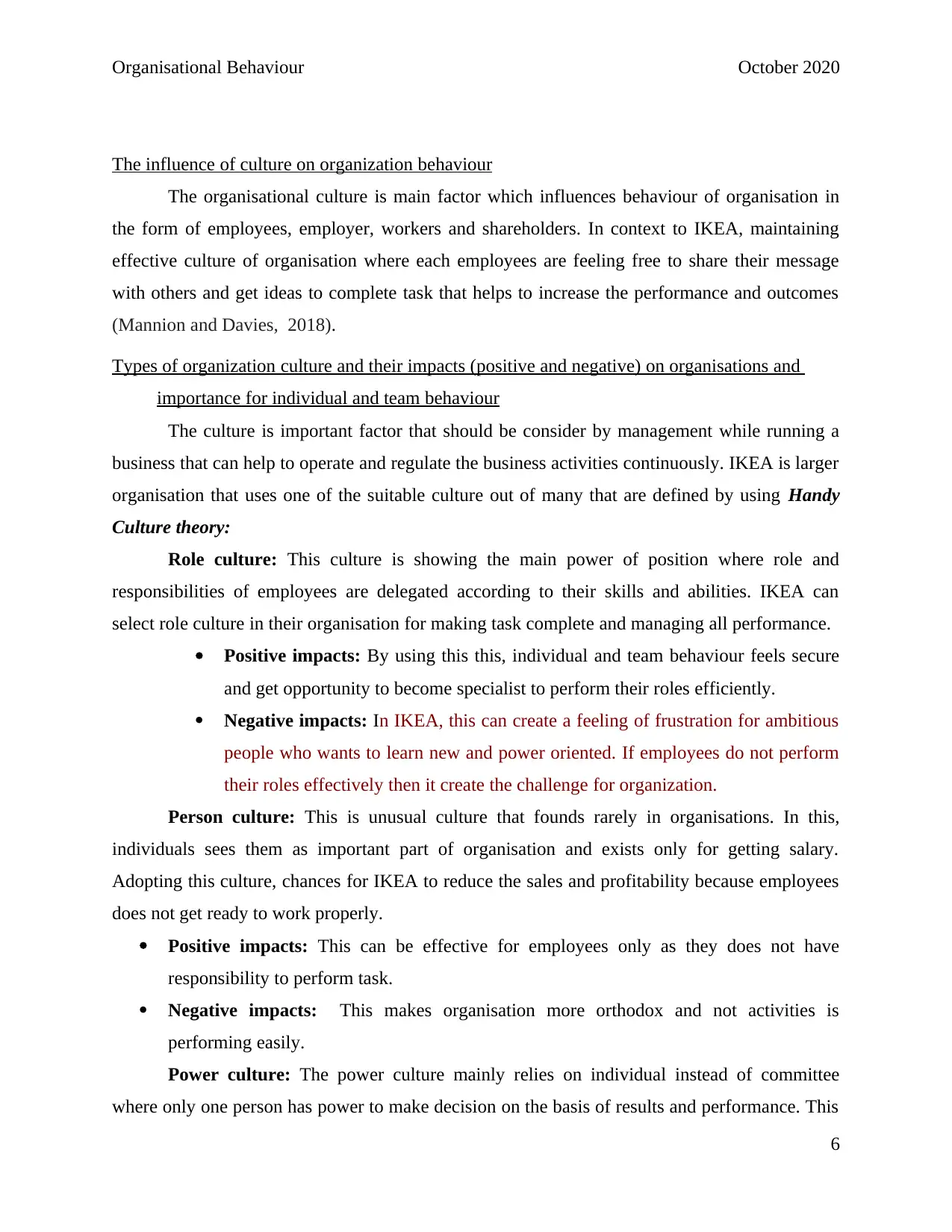
Organisational Behaviour October 2020
The influence of culture on organization behaviour
The organisational culture is main factor which influences behaviour of organisation in
the form of employees, employer, workers and shareholders. In context to IKEA, maintaining
effective culture of organisation where each employees are feeling free to share their message
with others and get ideas to complete task that helps to increase the performance and outcomes
(Mannion and Davies, 2018).
Types of organization culture and their impacts (positive and negative) on organisations and
importance for individual and team behaviour
The culture is important factor that should be consider by management while running a
business that can help to operate and regulate the business activities continuously. IKEA is larger
organisation that uses one of the suitable culture out of many that are defined by using Handy
Culture theory:
Role culture: This culture is showing the main power of position where role and
responsibilities of employees are delegated according to their skills and abilities. IKEA can
select role culture in their organisation for making task complete and managing all performance.
Positive impacts: By using this this, individual and team behaviour feels secure
and get opportunity to become specialist to perform their roles efficiently.
Negative impacts: In IKEA, this can create a feeling of frustration for ambitious
people who wants to learn new and power oriented. If employees do not perform
their roles effectively then it create the challenge for organization.
Person culture: This is unusual culture that founds rarely in organisations. In this,
individuals sees them as important part of organisation and exists only for getting salary.
Adopting this culture, chances for IKEA to reduce the sales and profitability because employees
does not get ready to work properly.
Positive impacts: This can be effective for employees only as they does not have
responsibility to perform task.
Negative impacts: This makes organisation more orthodox and not activities is
performing easily.
Power culture: The power culture mainly relies on individual instead of committee
where only one person has power to make decision on the basis of results and performance. This
6
The influence of culture on organization behaviour
The organisational culture is main factor which influences behaviour of organisation in
the form of employees, employer, workers and shareholders. In context to IKEA, maintaining
effective culture of organisation where each employees are feeling free to share their message
with others and get ideas to complete task that helps to increase the performance and outcomes
(Mannion and Davies, 2018).
Types of organization culture and their impacts (positive and negative) on organisations and
importance for individual and team behaviour
The culture is important factor that should be consider by management while running a
business that can help to operate and regulate the business activities continuously. IKEA is larger
organisation that uses one of the suitable culture out of many that are defined by using Handy
Culture theory:
Role culture: This culture is showing the main power of position where role and
responsibilities of employees are delegated according to their skills and abilities. IKEA can
select role culture in their organisation for making task complete and managing all performance.
Positive impacts: By using this this, individual and team behaviour feels secure
and get opportunity to become specialist to perform their roles efficiently.
Negative impacts: In IKEA, this can create a feeling of frustration for ambitious
people who wants to learn new and power oriented. If employees do not perform
their roles effectively then it create the challenge for organization.
Person culture: This is unusual culture that founds rarely in organisations. In this,
individuals sees them as important part of organisation and exists only for getting salary.
Adopting this culture, chances for IKEA to reduce the sales and profitability because employees
does not get ready to work properly.
Positive impacts: This can be effective for employees only as they does not have
responsibility to perform task.
Negative impacts: This makes organisation more orthodox and not activities is
performing easily.
Power culture: The power culture mainly relies on individual instead of committee
where only one person has power to make decision on the basis of results and performance. This
6
⊘ This is a preview!⊘
Do you want full access?
Subscribe today to unlock all pages.

Trusted by 1+ million students worldwide
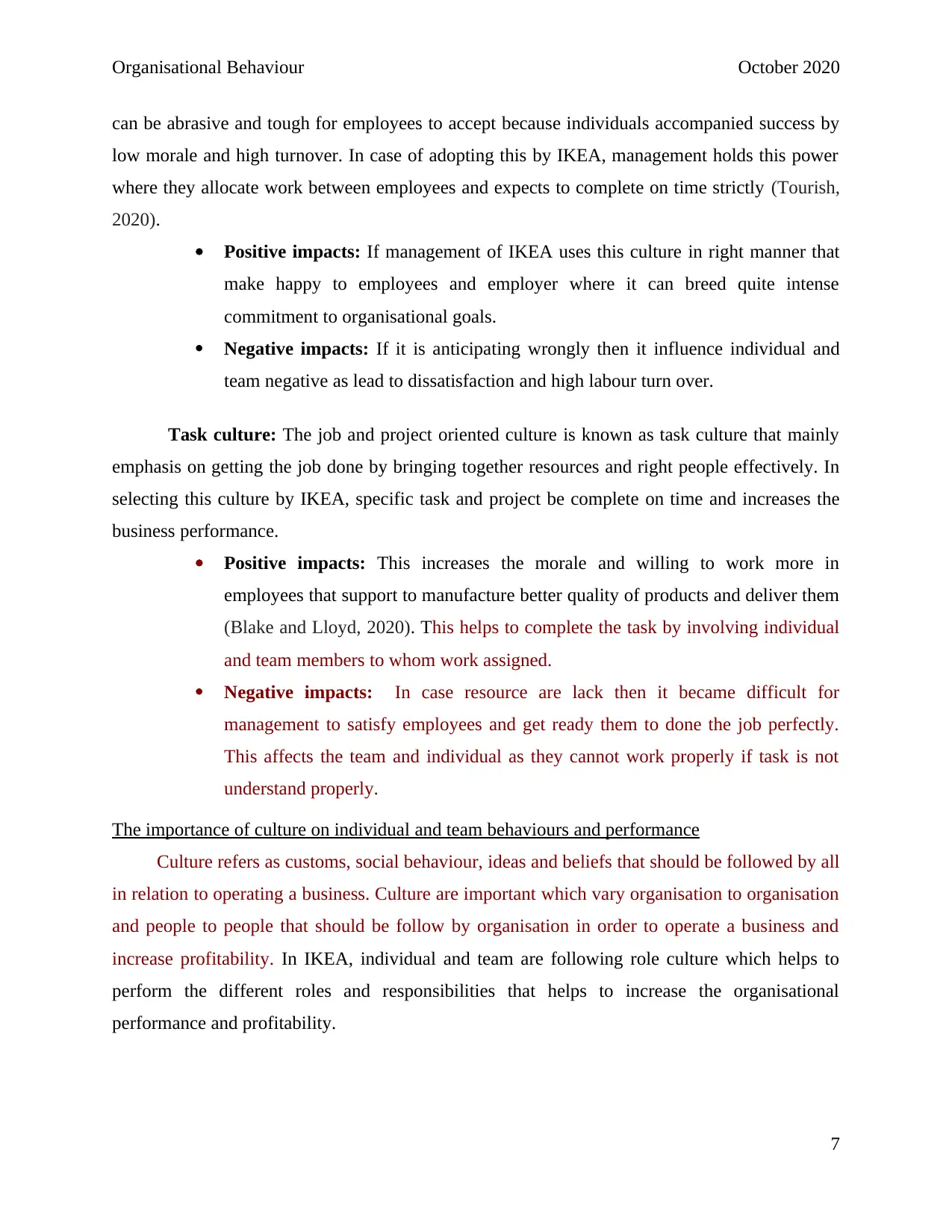
Organisational Behaviour October 2020
can be abrasive and tough for employees to accept because individuals accompanied success by
low morale and high turnover. In case of adopting this by IKEA, management holds this power
where they allocate work between employees and expects to complete on time strictly (Tourish,
2020).
Positive impacts: If management of IKEA uses this culture in right manner that
make happy to employees and employer where it can breed quite intense
commitment to organisational goals.
Negative impacts: If it is anticipating wrongly then it influence individual and
team negative as lead to dissatisfaction and high labour turn over.
Task culture: The job and project oriented culture is known as task culture that mainly
emphasis on getting the job done by bringing together resources and right people effectively. In
selecting this culture by IKEA, specific task and project be complete on time and increases the
business performance.
Positive impacts: This increases the morale and willing to work more in
employees that support to manufacture better quality of products and deliver them
(Blake and Lloyd, 2020). This helps to complete the task by involving individual
and team members to whom work assigned.
Negative impacts: In case resource are lack then it became difficult for
management to satisfy employees and get ready them to done the job perfectly.
This affects the team and individual as they cannot work properly if task is not
understand properly.
The importance of culture on individual and team behaviours and performance
Culture refers as customs, social behaviour, ideas and beliefs that should be followed by all
in relation to operating a business. Culture are important which vary organisation to organisation
and people to people that should be follow by organisation in order to operate a business and
increase profitability. In IKEA, individual and team are following role culture which helps to
perform the different roles and responsibilities that helps to increase the organisational
performance and profitability.
7
can be abrasive and tough for employees to accept because individuals accompanied success by
low morale and high turnover. In case of adopting this by IKEA, management holds this power
where they allocate work between employees and expects to complete on time strictly (Tourish,
2020).
Positive impacts: If management of IKEA uses this culture in right manner that
make happy to employees and employer where it can breed quite intense
commitment to organisational goals.
Negative impacts: If it is anticipating wrongly then it influence individual and
team negative as lead to dissatisfaction and high labour turn over.
Task culture: The job and project oriented culture is known as task culture that mainly
emphasis on getting the job done by bringing together resources and right people effectively. In
selecting this culture by IKEA, specific task and project be complete on time and increases the
business performance.
Positive impacts: This increases the morale and willing to work more in
employees that support to manufacture better quality of products and deliver them
(Blake and Lloyd, 2020). This helps to complete the task by involving individual
and team members to whom work assigned.
Negative impacts: In case resource are lack then it became difficult for
management to satisfy employees and get ready them to done the job perfectly.
This affects the team and individual as they cannot work properly if task is not
understand properly.
The importance of culture on individual and team behaviours and performance
Culture refers as customs, social behaviour, ideas and beliefs that should be followed by all
in relation to operating a business. Culture are important which vary organisation to organisation
and people to people that should be follow by organisation in order to operate a business and
increase profitability. In IKEA, individual and team are following role culture which helps to
perform the different roles and responsibilities that helps to increase the organisational
performance and profitability.
7
Paraphrase This Document
Need a fresh take? Get an instant paraphrase of this document with our AI Paraphraser
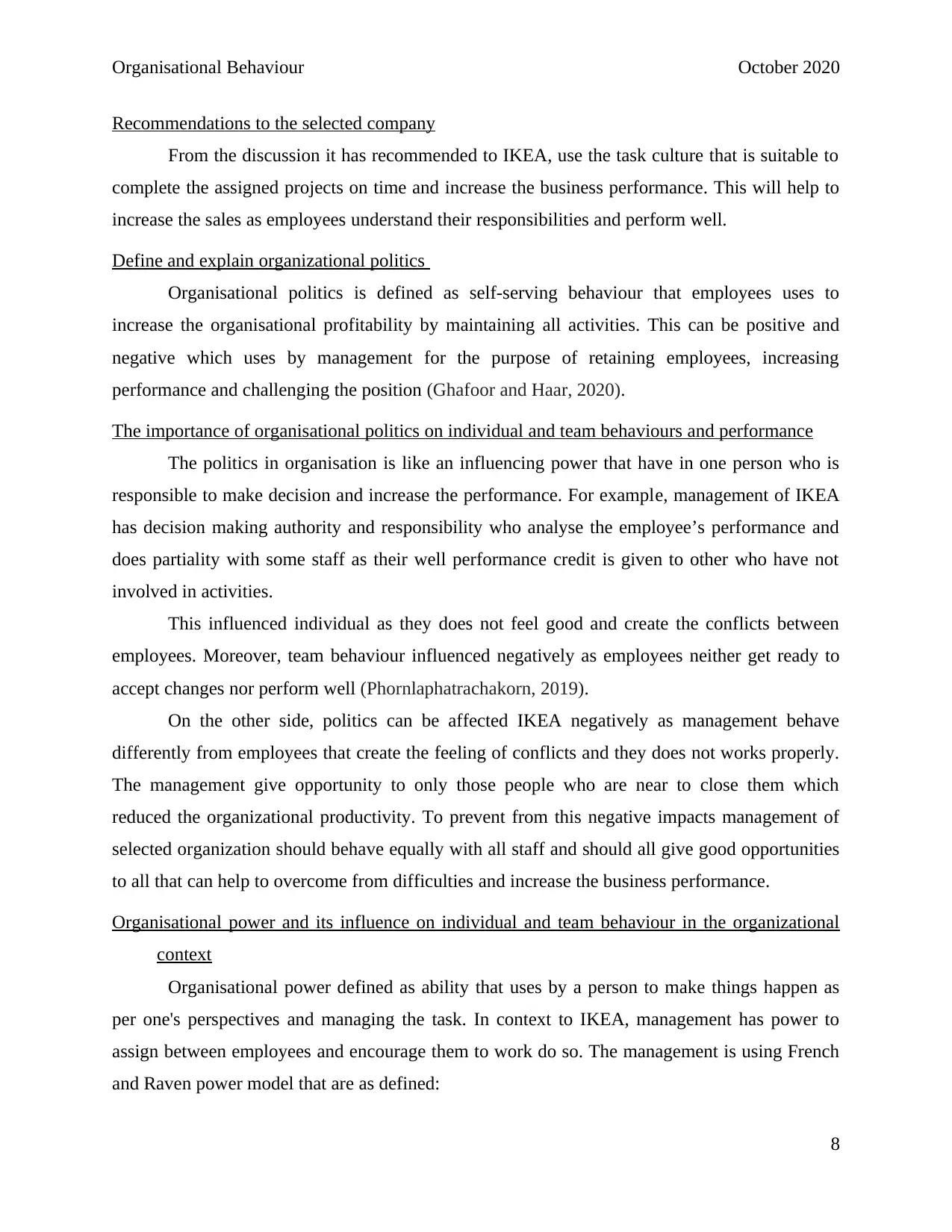
Organisational Behaviour October 2020
Recommendations to the selected company
From the discussion it has recommended to IKEA, use the task culture that is suitable to
complete the assigned projects on time and increase the business performance. This will help to
increase the sales as employees understand their responsibilities and perform well.
Define and explain organizational politics
Organisational politics is defined as self-serving behaviour that employees uses to
increase the organisational profitability by maintaining all activities. This can be positive and
negative which uses by management for the purpose of retaining employees, increasing
performance and challenging the position (Ghafoor and Haar, 2020).
The importance of organisational politics on individual and team behaviours and performance
The politics in organisation is like an influencing power that have in one person who is
responsible to make decision and increase the performance. For example, management of IKEA
has decision making authority and responsibility who analyse the employee’s performance and
does partiality with some staff as their well performance credit is given to other who have not
involved in activities.
This influenced individual as they does not feel good and create the conflicts between
employees. Moreover, team behaviour influenced negatively as employees neither get ready to
accept changes nor perform well (Phornlaphatrachakorn, 2019).
On the other side, politics can be affected IKEA negatively as management behave
differently from employees that create the feeling of conflicts and they does not works properly.
The management give opportunity to only those people who are near to close them which
reduced the organizational productivity. To prevent from this negative impacts management of
selected organization should behave equally with all staff and should all give good opportunities
to all that can help to overcome from difficulties and increase the business performance.
Organisational power and its influence on individual and team behaviour in the organizational
context
Organisational power defined as ability that uses by a person to make things happen as
per one's perspectives and managing the task. In context to IKEA, management has power to
assign between employees and encourage them to work do so. The management is using French
and Raven power model that are as defined:
8
Recommendations to the selected company
From the discussion it has recommended to IKEA, use the task culture that is suitable to
complete the assigned projects on time and increase the business performance. This will help to
increase the sales as employees understand their responsibilities and perform well.
Define and explain organizational politics
Organisational politics is defined as self-serving behaviour that employees uses to
increase the organisational profitability by maintaining all activities. This can be positive and
negative which uses by management for the purpose of retaining employees, increasing
performance and challenging the position (Ghafoor and Haar, 2020).
The importance of organisational politics on individual and team behaviours and performance
The politics in organisation is like an influencing power that have in one person who is
responsible to make decision and increase the performance. For example, management of IKEA
has decision making authority and responsibility who analyse the employee’s performance and
does partiality with some staff as their well performance credit is given to other who have not
involved in activities.
This influenced individual as they does not feel good and create the conflicts between
employees. Moreover, team behaviour influenced negatively as employees neither get ready to
accept changes nor perform well (Phornlaphatrachakorn, 2019).
On the other side, politics can be affected IKEA negatively as management behave
differently from employees that create the feeling of conflicts and they does not works properly.
The management give opportunity to only those people who are near to close them which
reduced the organizational productivity. To prevent from this negative impacts management of
selected organization should behave equally with all staff and should all give good opportunities
to all that can help to overcome from difficulties and increase the business performance.
Organisational power and its influence on individual and team behaviour in the organizational
context
Organisational power defined as ability that uses by a person to make things happen as
per one's perspectives and managing the task. In context to IKEA, management has power to
assign between employees and encourage them to work do so. The management is using French
and Raven power model that are as defined:
8
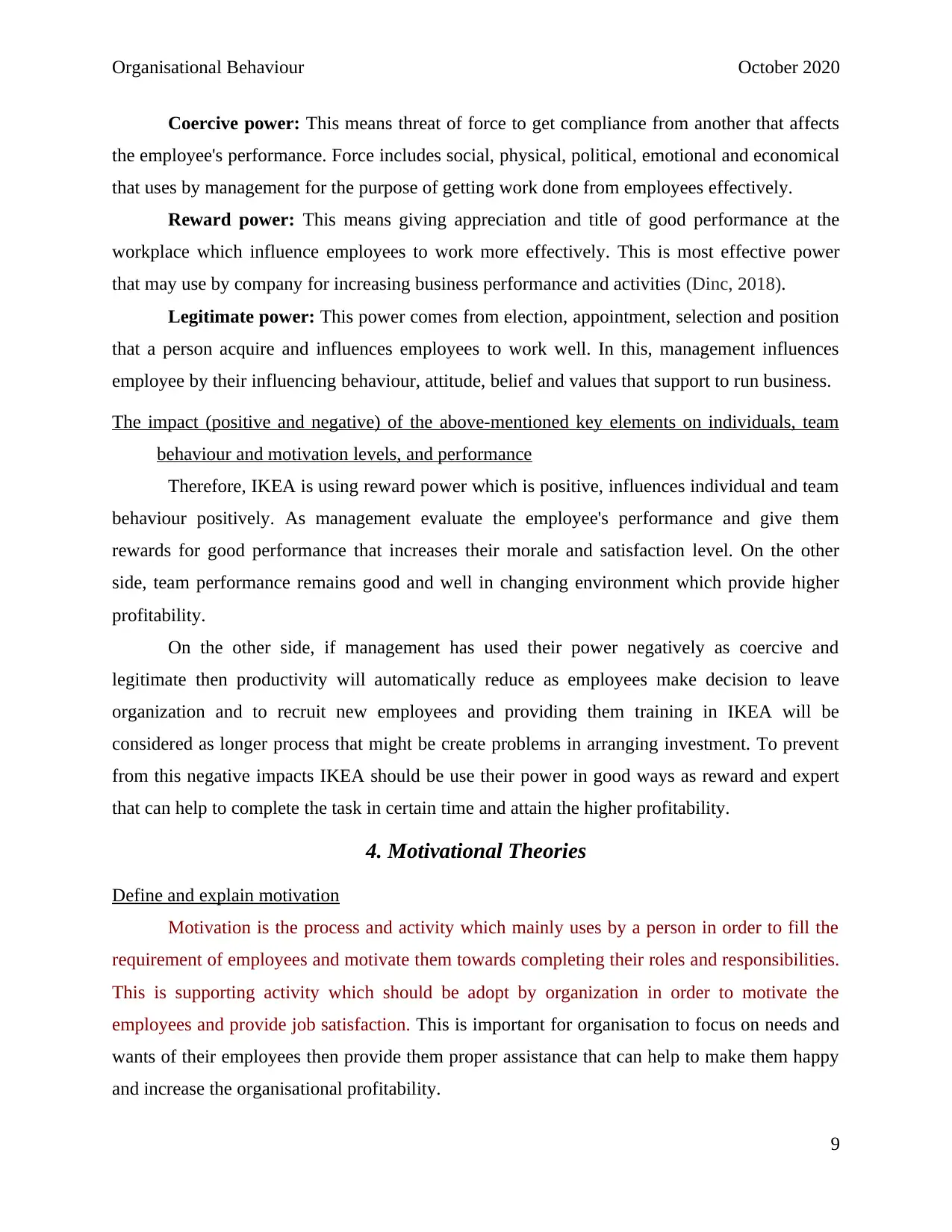
Organisational Behaviour October 2020
Coercive power: This means threat of force to get compliance from another that affects
the employee's performance. Force includes social, physical, political, emotional and economical
that uses by management for the purpose of getting work done from employees effectively.
Reward power: This means giving appreciation and title of good performance at the
workplace which influence employees to work more effectively. This is most effective power
that may use by company for increasing business performance and activities (Dinc, 2018).
Legitimate power: This power comes from election, appointment, selection and position
that a person acquire and influences employees to work well. In this, management influences
employee by their influencing behaviour, attitude, belief and values that support to run business.
The impact (positive and negative) of the above-mentioned key elements on individuals, team
behaviour and motivation levels, and performance
Therefore, IKEA is using reward power which is positive, influences individual and team
behaviour positively. As management evaluate the employee's performance and give them
rewards for good performance that increases their morale and satisfaction level. On the other
side, team performance remains good and well in changing environment which provide higher
profitability.
On the other side, if management has used their power negatively as coercive and
legitimate then productivity will automatically reduce as employees make decision to leave
organization and to recruit new employees and providing them training in IKEA will be
considered as longer process that might be create problems in arranging investment. To prevent
from this negative impacts IKEA should be use their power in good ways as reward and expert
that can help to complete the task in certain time and attain the higher profitability.
4. Motivational Theories
Define and explain motivation
Motivation is the process and activity which mainly uses by a person in order to fill the
requirement of employees and motivate them towards completing their roles and responsibilities.
This is supporting activity which should be adopt by organization in order to motivate the
employees and provide job satisfaction. This is important for organisation to focus on needs and
wants of their employees then provide them proper assistance that can help to make them happy
and increase the organisational profitability.
9
Coercive power: This means threat of force to get compliance from another that affects
the employee's performance. Force includes social, physical, political, emotional and economical
that uses by management for the purpose of getting work done from employees effectively.
Reward power: This means giving appreciation and title of good performance at the
workplace which influence employees to work more effectively. This is most effective power
that may use by company for increasing business performance and activities (Dinc, 2018).
Legitimate power: This power comes from election, appointment, selection and position
that a person acquire and influences employees to work well. In this, management influences
employee by their influencing behaviour, attitude, belief and values that support to run business.
The impact (positive and negative) of the above-mentioned key elements on individuals, team
behaviour and motivation levels, and performance
Therefore, IKEA is using reward power which is positive, influences individual and team
behaviour positively. As management evaluate the employee's performance and give them
rewards for good performance that increases their morale and satisfaction level. On the other
side, team performance remains good and well in changing environment which provide higher
profitability.
On the other side, if management has used their power negatively as coercive and
legitimate then productivity will automatically reduce as employees make decision to leave
organization and to recruit new employees and providing them training in IKEA will be
considered as longer process that might be create problems in arranging investment. To prevent
from this negative impacts IKEA should be use their power in good ways as reward and expert
that can help to complete the task in certain time and attain the higher profitability.
4. Motivational Theories
Define and explain motivation
Motivation is the process and activity which mainly uses by a person in order to fill the
requirement of employees and motivate them towards completing their roles and responsibilities.
This is supporting activity which should be adopt by organization in order to motivate the
employees and provide job satisfaction. This is important for organisation to focus on needs and
wants of their employees then provide them proper assistance that can help to make them happy
and increase the organisational profitability.
9
⊘ This is a preview!⊘
Do you want full access?
Subscribe today to unlock all pages.

Trusted by 1+ million students worldwide
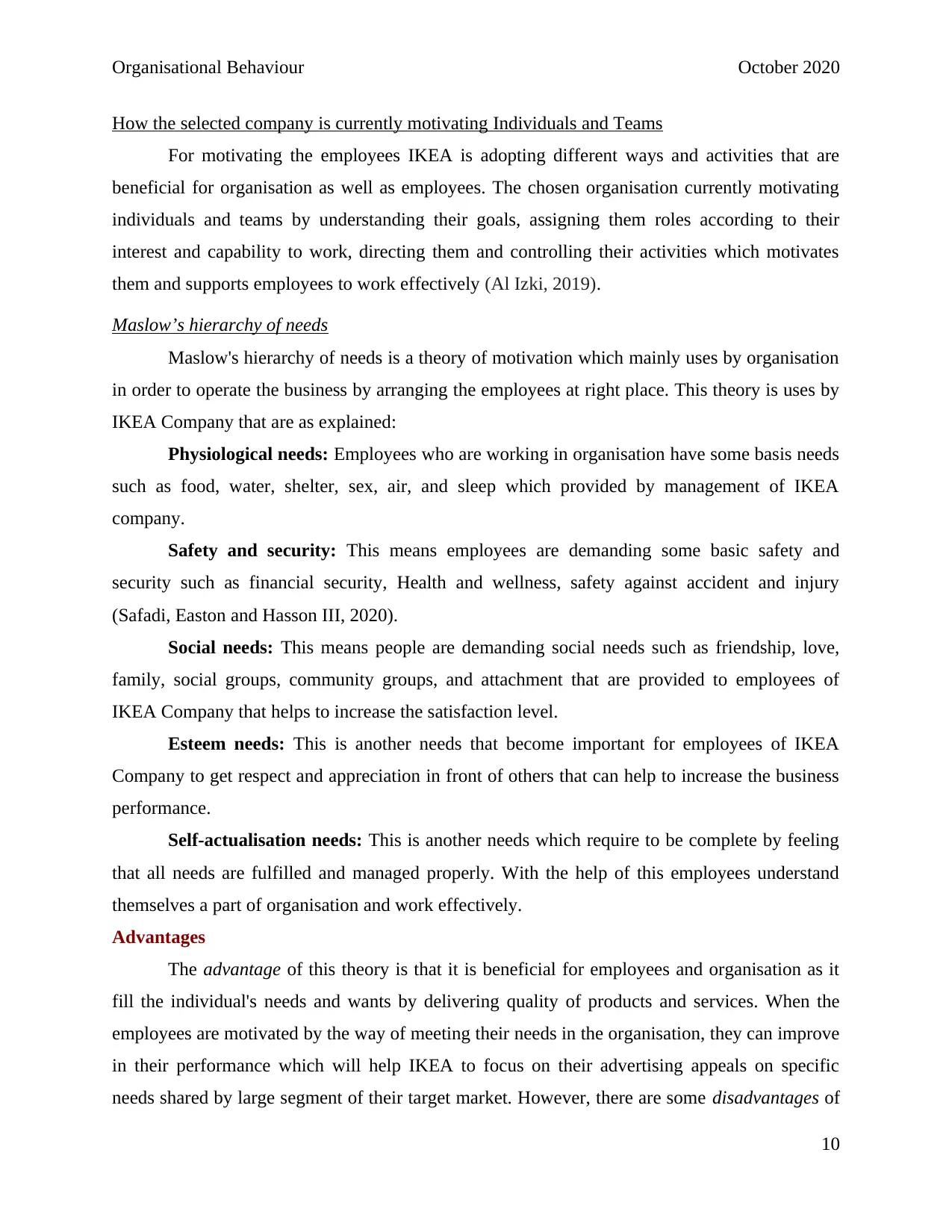
Organisational Behaviour October 2020
How the selected company is currently motivating Individuals and Teams
For motivating the employees IKEA is adopting different ways and activities that are
beneficial for organisation as well as employees. The chosen organisation currently motivating
individuals and teams by understanding their goals, assigning them roles according to their
interest and capability to work, directing them and controlling their activities which motivates
them and supports employees to work effectively (Al Izki, 2019).
Maslow’s hierarchy of needs
Maslow's hierarchy of needs is a theory of motivation which mainly uses by organisation
in order to operate the business by arranging the employees at right place. This theory is uses by
IKEA Company that are as explained:
Physiological needs: Employees who are working in organisation have some basis needs
such as food, water, shelter, sex, air, and sleep which provided by management of IKEA
company.
Safety and security: This means employees are demanding some basic safety and
security such as financial security, Health and wellness, safety against accident and injury
(Safadi, Easton and Hasson III, 2020).
Social needs: This means people are demanding social needs such as friendship, love,
family, social groups, community groups, and attachment that are provided to employees of
IKEA Company that helps to increase the satisfaction level.
Esteem needs: This is another needs that become important for employees of IKEA
Company to get respect and appreciation in front of others that can help to increase the business
performance.
Self-actualisation needs: This is another needs which require to be complete by feeling
that all needs are fulfilled and managed properly. With the help of this employees understand
themselves a part of organisation and work effectively.
Advantages
The advantage of this theory is that it is beneficial for employees and organisation as it
fill the individual's needs and wants by delivering quality of products and services. When the
employees are motivated by the way of meeting their needs in the organisation, they can improve
in their performance which will help IKEA to focus on their advertising appeals on specific
needs shared by large segment of their target market. However, there are some disadvantages of
10
How the selected company is currently motivating Individuals and Teams
For motivating the employees IKEA is adopting different ways and activities that are
beneficial for organisation as well as employees. The chosen organisation currently motivating
individuals and teams by understanding their goals, assigning them roles according to their
interest and capability to work, directing them and controlling their activities which motivates
them and supports employees to work effectively (Al Izki, 2019).
Maslow’s hierarchy of needs
Maslow's hierarchy of needs is a theory of motivation which mainly uses by organisation
in order to operate the business by arranging the employees at right place. This theory is uses by
IKEA Company that are as explained:
Physiological needs: Employees who are working in organisation have some basis needs
such as food, water, shelter, sex, air, and sleep which provided by management of IKEA
company.
Safety and security: This means employees are demanding some basic safety and
security such as financial security, Health and wellness, safety against accident and injury
(Safadi, Easton and Hasson III, 2020).
Social needs: This means people are demanding social needs such as friendship, love,
family, social groups, community groups, and attachment that are provided to employees of
IKEA Company that helps to increase the satisfaction level.
Esteem needs: This is another needs that become important for employees of IKEA
Company to get respect and appreciation in front of others that can help to increase the business
performance.
Self-actualisation needs: This is another needs which require to be complete by feeling
that all needs are fulfilled and managed properly. With the help of this employees understand
themselves a part of organisation and work effectively.
Advantages
The advantage of this theory is that it is beneficial for employees and organisation as it
fill the individual's needs and wants by delivering quality of products and services. When the
employees are motivated by the way of meeting their needs in the organisation, they can improve
in their performance which will help IKEA to focus on their advertising appeals on specific
needs shared by large segment of their target market. However, there are some disadvantages of
10
Paraphrase This Document
Need a fresh take? Get an instant paraphrase of this document with our AI Paraphraser
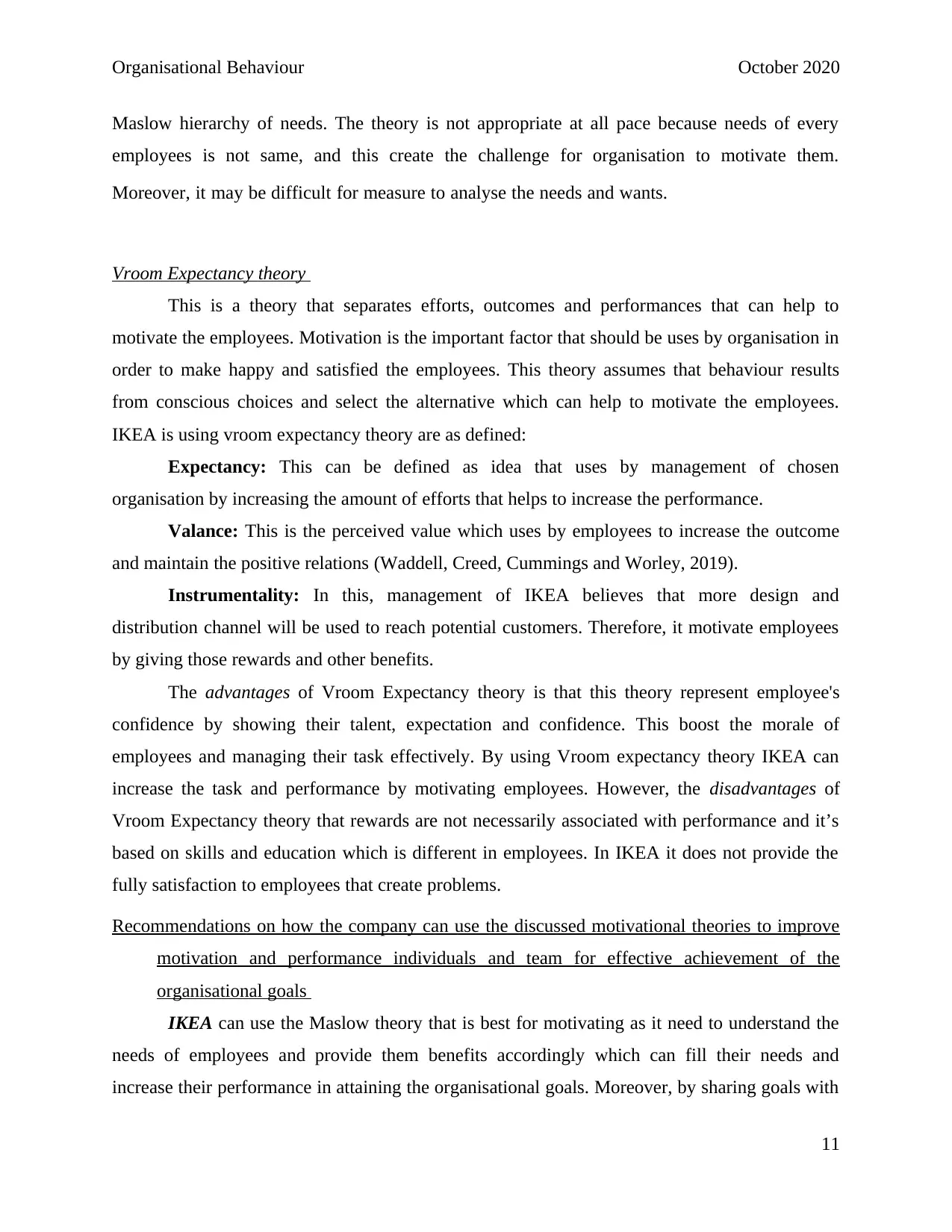
Organisational Behaviour October 2020
Maslow hierarchy of needs. The theory is not appropriate at all pace because needs of every
employees is not same, and this create the challenge for organisation to motivate them.
Moreover, it may be difficult for measure to analyse the needs and wants. This is generic and
weak
Vroom Expectancy theory
This is a theory that separates efforts, outcomes and performances that can help to
motivate the employees. Motivation is the important factor that should be uses by organisation in
order to make happy and satisfied the employees. This theory assumes that behaviour results
from conscious choices and select the alternative which can help to motivate the employees.
IKEA is using vroom expectancy theory are as defined:
Expectancy: This can be defined as idea that uses by management of chosen
organisation by increasing the amount of efforts that helps to increase the performance.
Valance: This is the perceived value which uses by employees to increase the outcome
and maintain the positive relations (Waddell, Creed, Cummings and Worley, 2019).
Instrumentality: In this, management of IKEA believes that more design and
distribution channel will be used to reach potential customers. Therefore, it motivate employees
by giving those rewards and other benefits.
The advantages of Vroom Expectancy theory is that this theory represent employee's
confidence by showing their talent, expectation and confidence. This boost the morale of
employees and managing their task effectively. By using Vroom expectancy theory IKEA can
increase the task and performance by motivating employees. However, the disadvantages of
Vroom Expectancy theory that rewards are not necessarily associated with performance and it’s
based on skills and education which is different in employees. In IKEA it does not provide the
fully satisfaction to employees that create problems.
Recommendations on how the company can use the discussed motivational theories to improve
motivation and performance individuals and team for effective achievement of the
organisational goals
IKEA can use the Maslow theory that is best for motivating as it need to understand the
needs of employees and provide them benefits accordingly which can fill their needs and
increase their performance in attaining the organisational goals. Moreover, by sharing goals with
11
Maslow hierarchy of needs. The theory is not appropriate at all pace because needs of every
employees is not same, and this create the challenge for organisation to motivate them.
Moreover, it may be difficult for measure to analyse the needs and wants. This is generic and
weak
Vroom Expectancy theory
This is a theory that separates efforts, outcomes and performances that can help to
motivate the employees. Motivation is the important factor that should be uses by organisation in
order to make happy and satisfied the employees. This theory assumes that behaviour results
from conscious choices and select the alternative which can help to motivate the employees.
IKEA is using vroom expectancy theory are as defined:
Expectancy: This can be defined as idea that uses by management of chosen
organisation by increasing the amount of efforts that helps to increase the performance.
Valance: This is the perceived value which uses by employees to increase the outcome
and maintain the positive relations (Waddell, Creed, Cummings and Worley, 2019).
Instrumentality: In this, management of IKEA believes that more design and
distribution channel will be used to reach potential customers. Therefore, it motivate employees
by giving those rewards and other benefits.
The advantages of Vroom Expectancy theory is that this theory represent employee's
confidence by showing their talent, expectation and confidence. This boost the morale of
employees and managing their task effectively. By using Vroom expectancy theory IKEA can
increase the task and performance by motivating employees. However, the disadvantages of
Vroom Expectancy theory that rewards are not necessarily associated with performance and it’s
based on skills and education which is different in employees. In IKEA it does not provide the
fully satisfaction to employees that create problems.
Recommendations on how the company can use the discussed motivational theories to improve
motivation and performance individuals and team for effective achievement of the
organisational goals
IKEA can use the Maslow theory that is best for motivating as it need to understand the
needs of employees and provide them benefits accordingly which can fill their needs and
increase their performance in attaining the organisational goals. Moreover, by sharing goals with
11
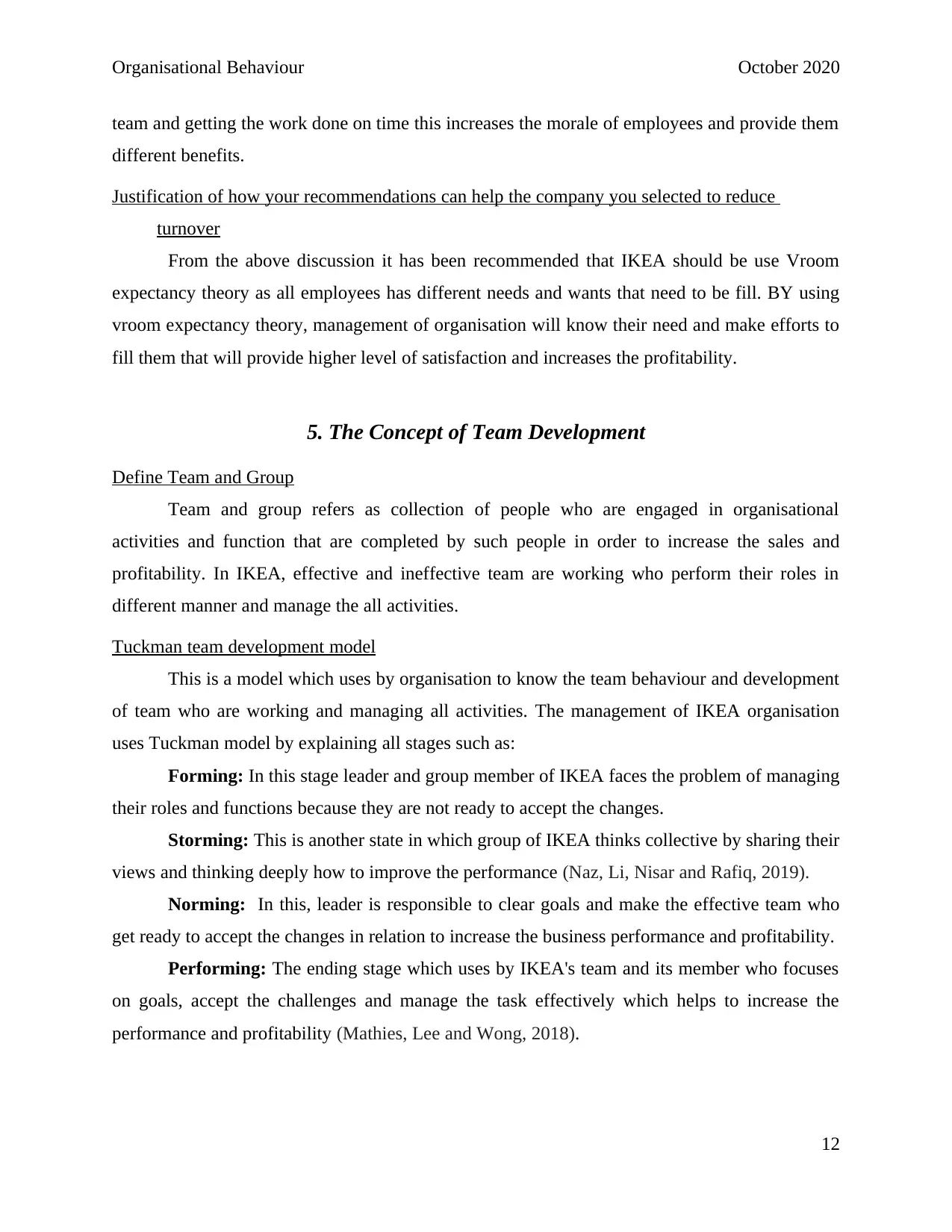
Organisational Behaviour October 2020
team and getting the work done on time this increases the morale of employees and provide them
different benefits.
Justification of how your recommendations can help the company you selected to reduce
turnover
From the above discussion it has been recommended that IKEA should be use Vroom
expectancy theory as all employees has different needs and wants that need to be fill. BY using
vroom expectancy theory, management of organisation will know their need and make efforts to
fill them that will provide higher level of satisfaction and increases the profitability.
5. The Concept of Team Development
Define Team and Group
Team and group refers as collection of people who are engaged in organisational
activities and function that are completed by such people in order to increase the sales and
profitability. In IKEA, effective and ineffective team are working who perform their roles in
different manner and manage the all activities.
Tuckman team development model
This is a model which uses by organisation to know the team behaviour and development
of team who are working and managing all activities. The management of IKEA organisation
uses Tuckman model by explaining all stages such as:
Forming: In this stage leader and group member of IKEA faces the problem of managing
their roles and functions because they are not ready to accept the changes.
Storming: This is another state in which group of IKEA thinks collective by sharing their
views and thinking deeply how to improve the performance (Naz, Li, Nisar and Rafiq, 2019).
Norming: In this, leader is responsible to clear goals and make the effective team who
get ready to accept the changes in relation to increase the business performance and profitability.
Performing: The ending stage which uses by IKEA's team and its member who focuses
on goals, accept the challenges and manage the task effectively which helps to increase the
performance and profitability (Mathies, Lee and Wong, 2018).
12
team and getting the work done on time this increases the morale of employees and provide them
different benefits.
Justification of how your recommendations can help the company you selected to reduce
turnover
From the above discussion it has been recommended that IKEA should be use Vroom
expectancy theory as all employees has different needs and wants that need to be fill. BY using
vroom expectancy theory, management of organisation will know their need and make efforts to
fill them that will provide higher level of satisfaction and increases the profitability.
5. The Concept of Team Development
Define Team and Group
Team and group refers as collection of people who are engaged in organisational
activities and function that are completed by such people in order to increase the sales and
profitability. In IKEA, effective and ineffective team are working who perform their roles in
different manner and manage the all activities.
Tuckman team development model
This is a model which uses by organisation to know the team behaviour and development
of team who are working and managing all activities. The management of IKEA organisation
uses Tuckman model by explaining all stages such as:
Forming: In this stage leader and group member of IKEA faces the problem of managing
their roles and functions because they are not ready to accept the changes.
Storming: This is another state in which group of IKEA thinks collective by sharing their
views and thinking deeply how to improve the performance (Naz, Li, Nisar and Rafiq, 2019).
Norming: In this, leader is responsible to clear goals and make the effective team who
get ready to accept the changes in relation to increase the business performance and profitability.
Performing: The ending stage which uses by IKEA's team and its member who focuses
on goals, accept the challenges and manage the task effectively which helps to increase the
performance and profitability (Mathies, Lee and Wong, 2018).
12
⊘ This is a preview!⊘
Do you want full access?
Subscribe today to unlock all pages.

Trusted by 1+ million students worldwide
1 out of 22
Related Documents
Your All-in-One AI-Powered Toolkit for Academic Success.
+13062052269
info@desklib.com
Available 24*7 on WhatsApp / Email
![[object Object]](/_next/static/media/star-bottom.7253800d.svg)
Unlock your academic potential
Copyright © 2020–2025 A2Z Services. All Rights Reserved. Developed and managed by ZUCOL.


